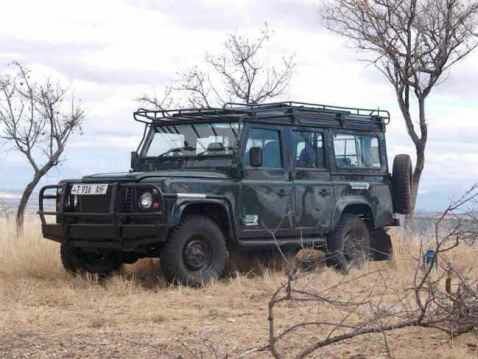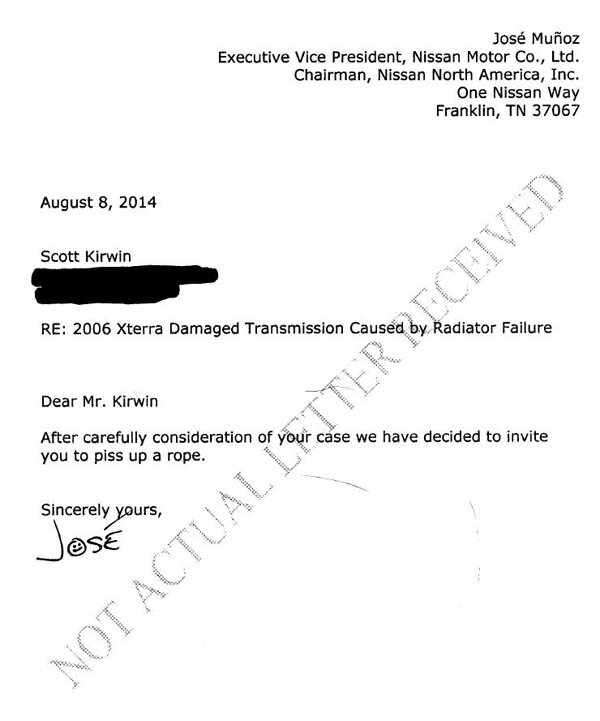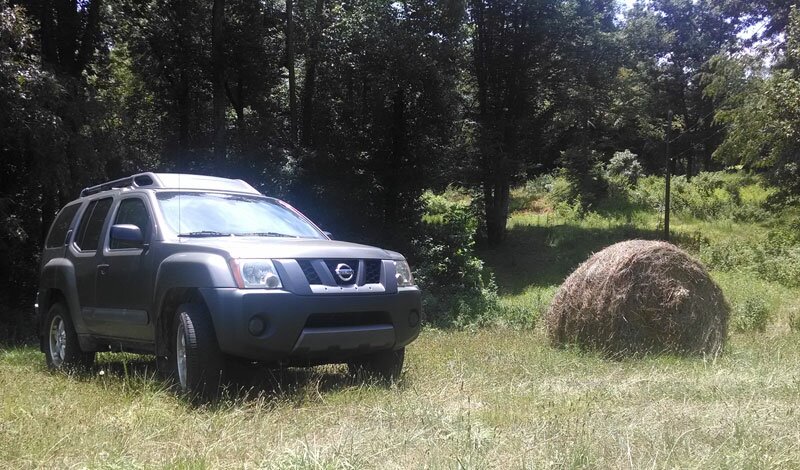In 2005 to celebrate her impending graduation from medical school the Wife decided that she wanted to buy a new car. Since she is obsessed with Africa, her idea of transportation is this:

(photo credit: Muda Mrefu)
Of course we didn’t have the money for a Land Rover, particularly one that comes with dents from rhinos, so she ended up settling on a Nissan Xterra. I wasn’t very keen on the truck. Although I had nothing against Nissans the Xterra got terrible gas mileage (17-19 mpg at first) and seemed to be more truck than she needed. But Wife gets what Wife wants, and so we used the USAA car buying service to find and price the Xterra she wanted. We drove to the dealer after settling on a car and price, but as we sat down the dealer refused to sell us the truck at the price negotiated by USAA. Our first mistake was not walking out, but with a youngster in tow and a crest-fallen wife I tried to negotiate the deal myself on the spot – which means I got screwed. I ended up paying about $2,000 more than planned for a stripped down model instead of the fully appointed one USAA promised.
At first things went okay. The Wife took the truck up to northern Pennsylvania on her rural rotation and the truck seemed to enjoy the rough roads. We quickly learned that while the exterior of the truck was pretty tough the interior suffered from flimsy plastic and vinyl. Within weeks there was our first casualty: the cupholder snapped off from rear of the passenger console. On one of the maintenance runs to the dealership we asked for a replacement. They said since we broke it, it wasn’t covered by the warranty. They wanted to charge us $500 for the cupholder. A few months later the dog’s claws had punctured through the vinyl cover of the console; also not under warranty – but we spent $400 replacing the vinyl.
The sound system that came with the truck was terrible. Everything that played sounded flat and almost mono. First I replaced the speakers, and there was no change. Then I replaced the car stereo with the exact same Panasonic model I used in my ‘99 Honda. While music sounded better there was something about the truck’s acoustics that just ruined it. It didn’t matter if you were listening to Bach or Bad Brains the sound always seemed smashed together with no bass or treble highlights to speak of.
But hey, we’re adults. We can live with bad sound. What we couldn’t deal with was the gradual decline of the car as soon as the warranty expired. The wheels ate bearings like tic-tacs to the point where once the mechanic needed to heat the axle in order to free them. All four wheels had their bearings and associated control rods replaced at least twice during our 8 years of ownership.
For some reason the car couldn’t maintain alignment which caused me to burn through tires, a problem I exacerbated by buying larger alloy wheels. Yes I am an idiot. I thought that bigger tires would provide the Wife a better ride. All I did was jack up the cost of each tire by $30; there was no change to the ride. I tried to rotate the tires every few months and had the truck aligned about twice a year but never managed to get the treads to wear evenly. Several times I had the car aligned and brought it back to the shop immediately afterward only to be shown the computer printout stating the truck was aligned. It reached a point where I simply thought the roads were made concave and maybe higher center of gravity trucks were more sensitive to this than my Honda.
Small problems continued. I ended up downloading the manuals on the Xterra and hanging out on internet forums, doing the repairs myself. But then the big hits started coming.
First it was the rear differential, setting me back $2400 and a week of a car rental. Soon after that the check engine light started glowing and a trip to the dealership confirmed I needed new catalytic converters for $3,000. At this point the truck was just over 120,000 miles. I ended up replacing the catalytic converters elsewhere with non-OEM cats for $600 but that didn’t fix the problem with the codes. An investigation determined that the 2nd generation Nissan Xterras have cast iron exhaust manifolds bolted onto a cast aluminum engine. Since aluminum and iron expand at different rates, the manifolds tend to develop cracks which allow air into the exhaust. This extra air passes through the catalytic converter and makes the oxygen sensor report the catalytic converter is bad. Another $1000 problem.
On March 30, 2014 while on a business trip the heater stopped blowing warm air. A few minutes later the engine temperature spiked but then returned to normal, and after another 50 miles the heater began blowing warm again. After returning home I took the car to a local mechanic who discovered the transmission cooler within the radiator had failed, allowing radiator coolant to mix with transmission fluid. $600 replacement of the radiator and two system flushes later the transmission slips out of gear, often at critical moments like while turning in intersections. The car suddenly became undriveable, and I had to park it in my field.
It turns out the Nissan Xterra has a transmission computer that actually sits in the transmission fluid pan. As some of you PC geeks may know it is possible to submerse computers in oil or distilled water and have them work just fine. That’s because many oils and distilled water are non-conductive, so while it may look scary, as long as the computer is designed properly for the cooling medium, all will be well. Nissan engineers in their ultimate wisdom decided this was a good idea in the second generation trucks, although the computer was outside the transmission in the first generation trucks. Also they decided to embed the transmission radiator within the engine radiator. This should be no big deal; my Honda has the same configuration. What my Honda does have that the 2nd generation Xterra lacked was a well-made radiator. Nissan’s radiator was defective, and Nissan knows it.
So you have a computer embedded in transmission oil that is cooled through the radiator which uses a 50-50 mix of ethylene glycol and water. The transmission radiator within the engine radiator failed, allowing the antifreeze to sink into the transmission. This caused the overall fluid level to dip. Since the engineers also designed the heater to pull warm coolant from the top of the radiator, the drop in fluid kept the heater from warming up. Only when the engine had warmed up in the cold March air did the fluid expand enough to feed the heater.
But the damage was done. Transmission oil is non-conductive but antifreeze is, and the mixture shorted out the computer. The mixture of green radiator coolant with transmission fluid has even earned a name in the Nissan aficionado community: the Strawberry Milkshake of Death (SMOD) – because that’s exactly what it looks like. Pop off your radiator cap and you’ll find a milky reddish mix. But it’s far from delicious, and Nissan got sued over it.
In 2012 Nissan reached a class-action settlement whereby it extended the warranties of Nissan Xterras and Frontier pickup trucks to 80,000 miles full coverage, 90,000 miles with a $2,500 copay and 100,000 with a $3,000 copay. The meager offerings to Nissan owners only prove what I’ve always believed of class action lawsuits: they are income makers for lawyers and not for the plaintiffs. I never received notice of the settlement nor was I notified of any recall related to the problem.
By this point I was well past the settlement terms. So I did what I’ve done successfully many times in the past: I wrote a letter. I wrote to Jose Munoz, head of Nissan North America.
Mr. Muñoz, I grew up loving Datsun. When I see a 280z on the road I notice that I’m not the only one who turns his head to watch that legend slide passed. My very first car was a 1983 Sentra that I bought and taught myself how to drive stick on while leaving the dealer. I put 90k on that car while in college and it never let me down. So as I grew older I always considered Nissan whenever I needed to buy a new or used vehicle.
I like my Xterra. It’s a good solid car with the exception of the damage caused by a poorly engineered transmission cooler. Living in rural North Carolina I need the Xterra to safely take me and my family where we’re going on and off the roads. But the cost of the repair just doesn’t make economic sense and is too much for me to justify putting into the vehicle no matter how much I like it. Still, the idea of scrapping it just offends my environmental sensibilities. This car has many miles left on it before it ends up in a landfill, but I can’t risk driving it until it’s fixed.
Weeks passed and on Friday I heard back from Nissan North America.

Actually I didn’t get this letter in the mail, although that was the gist of a curt call I had from Meghan at Nissan North America.
So now the Xterra sits in the field waiting for me to decide what to do with it. Replacement of the transmission would run about $3,000. Then there’s still the check engine light issue to deal with plus new tires for another $2000. $5,000 into an 8 year old car with over a 150,000 miles doesn’t make sense. I’m driving my ‘99 Honda with close to 200,000 miles on it to dealerships pricing Toyotas and Hondas, and when asked whether I have a trade-in I don’t mention the Xterra because I don’t even know how I’d get it to the dealer to trade in.
As I wrote to Jose Munoz, she is a good looking truck. I can see her from where I write. No rust. No paint issues that a good buff couldn’t fix. She loves the dirt and the North Carolina dust, and she doesn’t look like a suppository the way other SUVs do. When the wife heard about my dealings with Nissan she texted me, “So sad I loved my Xterra but she has broken my heart.” But the wife has a new romance in her life, an Italian Fiat 500 convertible. And I have my trusty Honda CRV which I had ordered specially built for me from Saitama Japan. I’ve sworn the Honda will leave me through my cold-dead hands considering how little trouble that car has given me in 15 years of ownership.
I grew up in an era when few cars made it to 100,000 miles. I’ll never forget pushing my 1983 Dodge Omni into the Toyota dealership in 1987 at 45,000 miles. The car my mother bought with that trade was still going when she traded it in at 150,000 miles. Today used cars often have over 100,000 miles on them. But there are some around like the Nissan Xterra which might look good on the outside but just aren’t built to last the way Toyota 4Runners and Honda CRVs are. It’s been a long, expensive lesson for me.
If I had run that truck into the ground rest assured I wouldn’t have wasted time writing Nissan, but the fact that it has been a money pit since the warranty expired shows Nissan cannot stand up to its Japanese and European competition in terms of quality.
When I pushed that Dodge into the Toyota dealership I swore off American cars. Almost thirty years later I have not purchased a car made by Ford, GM or Chrysler. Nissan now joins that list.
Why complain? Why waste my time with all this writing? Because the only reason why we don’t pitch cars at the 100,000 mile mark today is because we stopped putting up with badly made cars in the 1970s and 1980s. Today there are many high quality vehicles on the road, but they are only there because consumers expect and demand them. If we let the automakers get sloppy the way the US automakers did in the 1960s and 1970s and don’t hold them to a higher standard of quality, then we’ll have only ourselves to blame.







